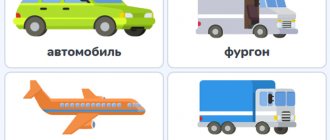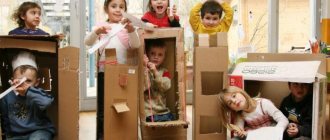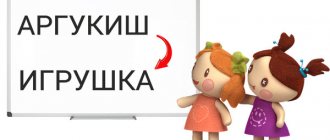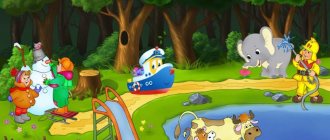- Why does a preschooler need to solve logic problems?
- Rules for solving logic problems for preschoolers
- Logic problems, assignments and games for preschoolers
Task for developing intelligence (for children aged 6, 7 years)
- Tasks for the development of creative abilities
- Logic problems - tests with answers
- Logic problems “Crossings and maneuvers”
- Entertaining tasks to develop logical thinking in preschoolers
The main and important point in the development of a preschooler is the formation of his logical thinking (this is precisely why it is necessary to solve logical problems!). Thanks to logic, you can explain life phenomena to a 5-6-7 year old child and justify your point of view. If you develop the ability to think and act logically in time, the child will definitely become a sane person.
To achieve this goal, parents and educators use various exciting and interesting games, create game situations of a logical nature, which makes classes not only interesting, but also very useful for small pets, as they are aimed at developing intelligence and thinking. Such tasks and games will force the little brain to reason, taking into account, first of all, logic.
We all know that children love to think, trying to show that they are adults. Yes, any adult will notice errors in reasoning, which are associated with an inaccurate logical structure of thought. The child very often reasons correctly and is close to the answer, but due to his lack of logic, it is difficult for him to explain or express his point of view. Adults will help him overcome this obstacle, and in this they will need logic games and tasks (tasks). When the baby finally gains the ability to think logically, he will easily be able to solve simple and complex problems that life will set for him.
Preschool children really like logic puzzles. They are interested in reasoning and flexing their brains. Many children, after reading a logical task, immediately give the correct answer, but not everyone can explain the course of their thoughts. Then the teacher or parent should help the student build a chain of thoughts using the correct methodology for working on tasks with a logical load.
Rules for solving logic problems for preschoolers
1. Spend up to 10 minutes exercising several times a week;
2. During the explanation, it is advisable to use visual materials (drawings, diagrams, tables);
3. Give the child a few minutes for his own reasoning, mandatory collective discussion, exchange of opinions;
4. You don’t have to write down tasks in your notebook;
5. When analyzing a logical problem, it is necessary to pay attention to the initiative and perseverance of students, help them find the answer thanks to correctly posed questions, and also explain beautiful and original solutions;
6. If the task turns out to be difficult, it is advisable to think at home.
Below are logic problems that are constantly used by teachers in their work, and most importantly, preschoolers readily solve them.
Finding errors and inconsistencies
These tasks are an excellent tool for training attention and it is not important that the child learns not to immediately take the information received on faith, but to think for a while.
For such tasks, you can use fable pictures (for non-speakers) or in the form of fable poems, for example:
- Sasha ate soup, so he is hungry;
- Ilona couldn’t come home, so she forgot her keys, etc.
By the way, such tasks are very useful for correcting agrammatisms and developing a full understanding of speech.
Logical tasks and games for preschoolers
Task for developing intelligence (for children aged 6, 7 years)
Among logic games, games for developing ingenuity occupy a significant place. They are lively, interesting, and you can learn a lot of new things from them. Such games allow the child to quickly switch from one activity to another, which helps develop logic. Games of wits help students win by showing their peers what they are capable of. Lazy kids, looking at the victory of others, should try to manifest themselves through trial and error, force themselves to think. Thus, logic games for developing ingenuity are very useful for the overall development of children. Examples of such games.
Game "That's how I am!"
Children form a circle. The presenter points to one of the students and says: “That’s how I am!” After this command, the student begins counting and the players count one by one, but earlier the leader said that instead of some numbers it is necessary to say “That’s how I am!” Such numbers can be numbers that contain the number 6, or numbers divisible by 2, etc. (for example: 1, 2, 3, 4, 5, “that’s how I am,” 7, 8, etc. ). You need to play fast. If a player gets lost, he leaves the game. The counting starts all over again. One player must remain.
Tasks for the development of creative abilities
Unfortunately, very often parents believe that it is impossible to develop logical thinking in a child, since he should have such abilities from birth. This is a wrong assumption. You should look closely at your baby, find hidden talents, and develop these talents from an early age. But in order to better achieve this goal, the child needs to create comfort and a good atmosphere.
Psychologists offer many games for developing creative abilities, in particular coloring books and exercises with completing pictures.
Game “Complete the picture”
Fourth wheel
Ask your child what is unnecessary, then ask them to justify it. For example:
- sundress, shirt, boots, fur coat (boots - shoes);
- cabbage, plum, eggplant, beet (plum is a fruit);
- pig, wolf, fox, deer (pig is a domestic animal);
- chest of drawers, cabinet, wardrobe, sofa (sofa - upholstered furniture).
In this case, more complex categories are again used than at the previous stage, since the child must know more about the world around him.
Assignments - tests (with answers) for children from 5 years old
Logical tasks also include tasks - tests. These tests contain one correct answer.
Task 1. Kolya, Anya and Nastya went into the forest and found 4 mushrooms. How many mushrooms would the children find if only Kolya and Anechka left?
a) 0; b) 1; at 2; d) 3; e) 4. (Correct answer.)
Solution. The number of mushrooms does not depend on the number of children who found them.
Problem 2. Alice had 3 ribbons. One of them was torn in half. How many ribbons does the girl have now?
a) 1; b) 3; at 4; (Correct answer.) d) 5.
Solution. Alice has two whole ribbons, and from one torn one two were formed. That is, the girl now has: 2 + 2 = 4 ribbons.
Task 3. Kostya wrote OLYA MALA on a piece of paper and went to the mirror. What phrase can you see in the mirror?
a) Olya small; b) SMALL OLIA; c) ALAM YALO; (correct answer.) d YALO ALAM.
Solution. Since all the letters of the written words are symmetrical, they will remain the same letters in the mirror. But they are located in the opposite direction. That is, two words are formed, written from the end. Experiment with paper in front of a mirror.
Problem 4. 8 children were playing in the yard. When mom called for lunch, Mariyka, Dima, Seryozha, Timofey, Uncle Nikolai and Grandfather Nikolai came running to the table from the yard. How many children are left playing in the yard?
a) 2; b) 3; at 5; d) 4. (Correct answer.)
Solution. Among all those who came running to their mother’s call, the children are Masha, Dima, Seryozha and Timofey, that is, four children came running. There are 8 – 4 = 4 children left to play in the yard.
Logic problems “Crossings and maneuvers”
Interesting logic problems are logical crossing problems and maneuvers. These exercises focus on difficult situations involving the crossing of animals or objects. It is necessary to come up with some way or algorithm to do this. They are usually called maneuvers. In crossing tasks, you need to transport something or someone or change places, observing some rules.
Problem 1. Two hungry dragons are resting on the left bank of the stream, and a defenseless kitten Vasya is sitting on the right bank of the stream. The Lord of the Dragons, Uncle Mitya, plies between the banks on his longboat. It is forbidden to leave a dragon and a kitten unattended on one of the banks, and more than one animal cannot be placed on a longboat. How can Uncle Mitya transport the dragons to the right bank and the kitten to the left?
Clue. First of all, the Lord of the Dragons, Uncle Mitya, must take one of the dragons with him.
Solution. To solve the problem, the lord of the dragons really first needs to take one of the dragons with him to the opposite shore, but there is a defenseless kitten sitting on the shore, therefore, having transported the dragon, Mitya will have to take the kitten with him to the opposite shore, on which there is still one dragon left. Uncle Mitya will take this dragon that remains with him and transport it to the right bank, and leave the kitten on the left bank. Thus, the lord of the dragons, Uncle Mitya, will transport the kitten to the left bank and the dragons to the right in three swims.
Problem 2. Two travelers approached the river. On the river bank a boat was found that could carry only one person. However, they were able to cross the river and continue their journey. How could this be?
Clue. Maybe they weren't walking together?
Solution. This is possible if they approached the river from different banks. Then the first crossed to the shore of the second, and the second to the shore of the first.
Task 3. The simplest maneuver exercise is to place three balls in the opposite direction. You can only change two adjacent ones.
The solution is very simple - change the balls one by one until you hold the desired one.
The proposed logic tasks are a good way to develop mathematical thinking and increase the activity of thought. With constant use of these, you can get high positive results in the development of logical thinking.
Entertaining tasks to develop logical thinking in preschoolers
A lot of tasks and logic games, as well as puzzles for children from 4 to 7 years old, can be found in the manual by Z.A. Mikhailova "Entertaining tasks for preschoolers."
The manual contains tasks, games, and puzzles for working with children aged 4-7 years. The material is presented in a certain system, which is important for increasing the level of general mental development of children, preparing them for mastering a mathematics course at school, and for creative work in the future.
An example of a logical problem from a book to find a pattern:
Problem with sticks (matches):
Download the manual in pdf format for free
Analogies and Antonyms
Analogies help to update your vocabulary and find logical connections between words:
- the fork is for eating, and the knife is for…(cutting);
- boots are shoes, and shorts are...(clothing);
- It’s cold in winter, and ... (warm) in summer, etc.
Antonyms:
- thick – thin;
- cold - warm;
- harmful - useful;
- evil - good, etc.
These words and phrases are given as an example; you can come up with something of your own, but you need to select them depending on the child’s individual level of knowledge.
Logic tasks to test the readiness of a 6-7 year old child for school
An excellent collection of logical tasks for preschoolers, developed taking into account the Federal State Educational Standard. In total, this book has five sections with logical tasks - comparison, classification, patterns, spatial thinking, and inference. Each section contains 7-11 exercises, which are best performed in the order in which they are given in the collection.
Download a collection of tests and logic problems for preschoolers in pdf format
Visual-figurative thinking is a type of thinking characterized by reliance on ideas and images.
The functions of figurative thinking are associated with the representation of situations and changes in them that a person wants to obtain as a result of his activities that transform the situation.
A very important feature of imaginative thinking is the establishment of unusual, incredible combinations of objects and their properties. Speech is actively involved in visual-figurative thinking, which helps to name the sign and compare the signs.
Those. Visual-figurative thinking helps solve tasks mentally, without the participation of practical actions. The right hemisphere of the brain is responsible for this type of thinking.
Logic for children 5 - 7 years old
This manual contains very interesting tasks, assignments, exercises and games for the development of logical thinking in preschool children, aimed at comparing objects according to various criteria, highlighting significant differences between objects, generalization and classification. This book is recommended for use in kindergartens and at home for children to study together with their parents. This manual can be used to prepare for mathematics lessons at school.








